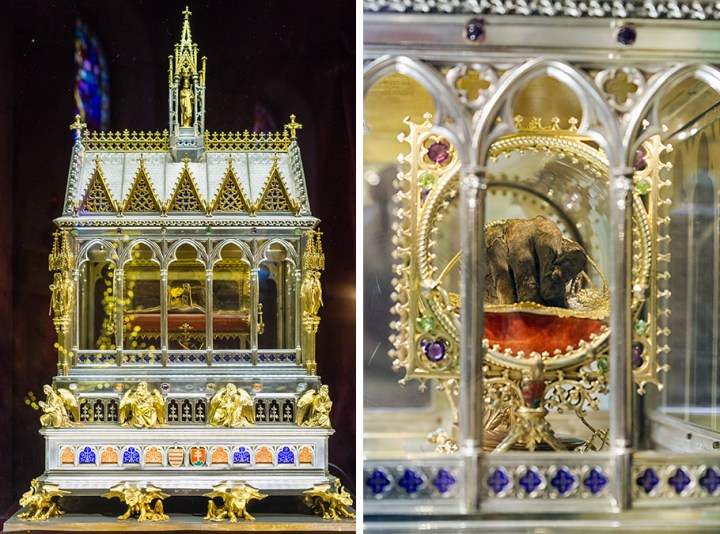From Aleteia
By Daniel Esparza
The Holy Right is the right fist of Saint Stephen of Hungary. The 1000-year-old relic has lived a long, often difficult life.
The practice of venerating relics (material items connected to the life of a saint) has clear biblical roots. Not unfrequently, we find passages in the Hebrew Bible where we objects that once belonged to a person considered holy being are used for miraculous purposes. Take, for example, the following passage from the Second Book of Kings (Cf. 2 Kings 13:20-21). The text reads:
And so Elisha died and was buried. At that time of year, bands of Moabites used to raid the land. Once some people were burying a man, when suddenly they saw such a raiding band. So they cast the man into the grave of Elisha, and everyone went off. But when the man came in contact with the bones of Elisha, he came back to life and got to his feet.
The same goes for the New Testament. The passage of the Gospel of Mark (Cf. Mark 5.27-29) featuring a woman miraculously healed after touching Jesus’ cloak is quite popular.
She had heard about Jesus and came up behind him in the crowd and touched his cloak. She said, ‘If I but touch his clothes, I shall be cured.’ Immediately her flow of blood dried up. She felt in her body that she was healed of her affliction.
The veneration of relics is not an exclusively Catholic custom —other religious traditions also show the very same kind of respect and reverence to objects intimately related to the lives of saintly men and women. In any case, Catholicism understands there are three kinds of relics —first, second, and third-class. A first-class relic is a physical remain of a saint (may it be his or her whole body, or even just a fragment of a bone, or a vial of blood). A second-class relic is any item that the saint might have used (most of the time, a piece of clothing). Finally, a third-class relic is any item that might have been in contact with either a first-class or a second-class relic.
Budapest, the Hungarian capital, preserves a unique first-class relic: the incorrupt right hand of its first Christian king, Szent István Király, King Saint Stephen.

The Holy Right Hand of St. Stephen, King of Hungary.
Shutterstock
Stephen I was the last Grand Prince of the Hungarians between 997 and 1000, and the firstKing of Hungary from 1000 (or 1001, according to other sources) until his death in 1038. Many details regarding his life are relatively uncertain: we do not know the year of his birth nor that of his baptism. We do know he was given the pagan name Vajk, that he was the only son of Grand Prince Géza and his wife, Sarolt, and that even if both of his parents were eventually baptized, Stephen was the first member of his family to become a devout Christian —he established several different Benedictine monasteries, encouraged the spread of Christianity, and brought peace to the region (at least during his reign), turning it into a popular route for pilgrims and merchants traveling between Western Europe, the Holy Land and Constantinople.
Every year, on his feast day (August 20th), The Holy Right, the right fist of St. Stephen himself, is taken out in a solemn procession. As part of his canonization process (back in 1083, a few decades after his death) his body was exhumed. Tradition claims his right arm was incorrupt. The whole arm was then preserved apart, for veneration, as a relic.
Here, the convolute story of the relic begins. It traveled all throughout Europe and only went back to Hungary after WWII. To keep it safe during the Tartar invasions of the 13th century, it was sent to Croatia, where Dominican friars housed it. Some sources claim it was then when the hand was cut from the arm —the upper arm being sent to Lemburg, and the hand to Vienna.
In 1771, authorities from the Austro-Hungarian empire decided to house the Holy Right in Schönbrunn Palace in Vienna, the Hapsburg’s summer home. They eventually sent it back to Hungary, but as soon as the war knocked on Budapest’s doors in 1944, the relic was again sent back to Austria, under the care of the archbishop of Salzburg. Finally, on August 20, 1945, a priest serving in the American army brought the hand from Austria back to Hungary. It is nowadays preserved in its reliquary, in the Basilica of St. Stephen.
No comments:
Post a Comment
Comments are subject to deletion if they are not germane. I have no problem with a bit of colourful language, but blasphemy or depraved profanity will not be allowed. Attacks on the Catholic Faith will not be tolerated. Comments will be deleted that are republican (Yanks! Note the lower case 'r'!), attacks on the legitimacy of Pope Leo XIV as the Vicar of Christ, the legitimacy of the House of Windsor or of the claims of the Elder Line of the House of France, or attacks on the legitimacy of any of the currently ruling Houses of Europe.